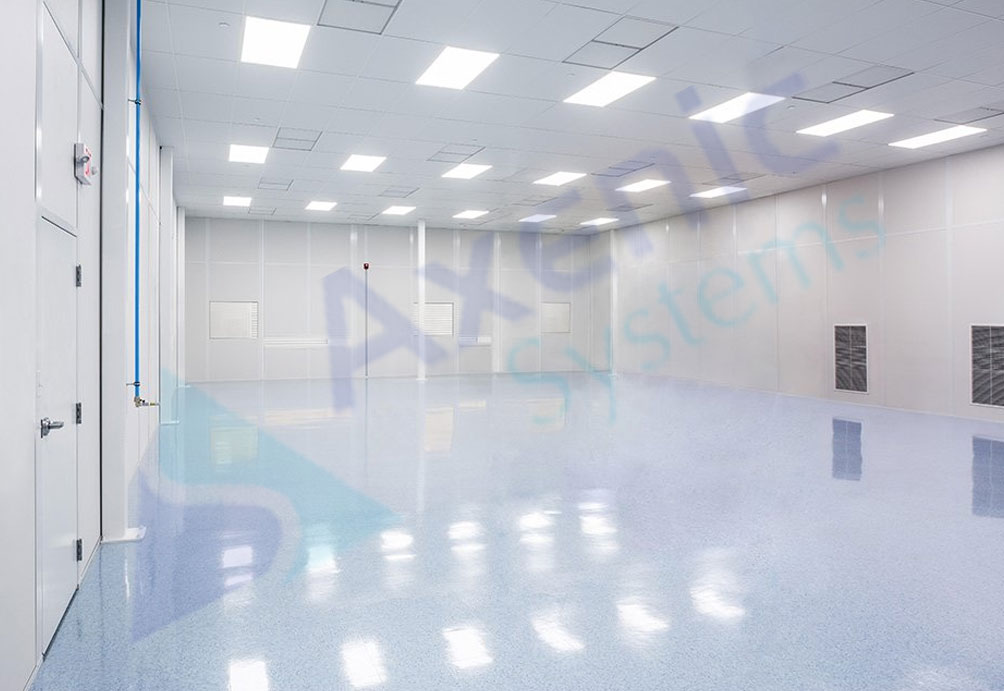Axenic System is one of the leading company engaged in architectural
designing, planning, installation, commissioning of HVAC and Turnkey
construction for cleanroom projects
Cleanroom ISO Standards
Table of Contents

Introduction Cleanroom ISO Standards
At AXENIC SYSTEMS (established in 1995), we can manufacture clean rooms that fulfil various ISO classifications, fs209e and ISO cleanroom standards. Whether you are looking for a less strict class 7 or 8 clean room, or need a class 4 that sustains the strictest cleaning standards, AXENIC SYSTEMS manufactures clean rooms according to exact specifications requirements.
ISO classifications are based on international standards that standardize the acceptable cleanliness levels of each level of room. International Organization for Standardization SO 14644-1 provides the guidance for the suitable air quality levels inside the specific clean room ISO classes. Additionally, the cleanroom class is determined by the level of cleanliness the room complies with, according to the amount and size of particles per volume of air.
Maximum number of particles in air by ISO class of cleanroom
| Class | Maximum Particles/m³ | FED STD 209E equivalent | |||||
| >0.1 um | >0.2 um | >0.3 um | >0.5 um | >1 um | >5 um | ||
| ISO 1 | 10 | 2 | |||||
| ISO 2 | 100 | 24 | 10 | 4 | |||
| ISO 3 | 1000 | 237 | 102 | 35 | 8 | Class 1 | |
| ISO 4 | 10000 | 2370 | 1020 | 352 | 83 | Class 10 | |
| ISO 5 | 100000 | 23700 | 10200 | 3520 | 832 | 29 | Class 100 |
| ISO 6 | 1000000 | 237000 | 102000 | 35200 | 8320 | 293 | Class 1,000 |
| ISO 7 | 352000 | 83200 | 2930 | Class 10,000 | |||
| ISO 8 | 3520000 | 832000 | 29300 | Class 100,000 | |||
| ISO 9 | 35200000 | 8320000 | 293000 | Room Air |
What is an ISO Clean Room?
ISO cleanroom is a particularly engineered and functionally designed enclosed area inside a manufacturing or research facility. These rooms enable for accurate control, monitoring and maintenance of an internal environment. Various ISO classifications are precisely designed to regulate:
- Temperature
- Humidity
- Airflow
- Filtration
- Pressure
Each room requires a different level of hygiene depending on the industry and application.
Cleanroom ISO Class Code Descriptions
Determining the right cleanroom standards for a new product or business needs balancing various aspects. These can include cost, process requirements, performance and construction. The staff members work hands-on with you to evaluate the basics of selection, and all applicable clean room industry requirements. Axenic provides cleanrooms by ISO class, as well as other cleanroom accessories to ensure superior air quality and particle filtering. The subsequent clean room classifications deliver the recommended air changes per hour, per class of cleanroom:
- ISO Class 1 – The “hygienic” cleanroom is ISO 1, used in industries like life sciences and electronics that need nanotechnology or ultra-fine particulate processing. The recommended air changes per hour for an ISO class 1 clean room is 500-750, and the ceiling coverage should be 80–100%.
- ISO Class 2 – 500-750 air changes per hour, with a ceiling coverage of 80-100%.
- ISO Class 3 – 500-750 air changes per hour, with a ceiling coverage of 60-100%.
- ISO Class 4 – 400-750 air changes per hour, with a ceiling coverage of 50-90%.
- ISO Class 5 – 240-600 air changes per hour, with a ceiling coverage of 35-70%.
- ISO Class 6 – 150-240 air changes per hour, with a ceiling coverage of 25-40%.
- ISO Class 7 – 60-150 air changes per hour, with a ceiling coverage of 15-25%.
- ISO Class 8 – 5-60 air changes per hour, with a ceiling coverage of 5-15%.
Cleanroom Industry Requirements & Classifications
Cleanroom standards and requirements are categorized according to the size and number of particles allowed per volume of air in a definite amount of time. The engineers provide guidelines and ISO class code descriptions for the class of cleanroom required for your particular application. Typically, companies and organizations are aware of their cleanroom performance requirements because of client, industry or government specifications. For example, government regulation USP 797 outlines precise requirements for pharmaceutical product manufacturing.
Cleanroom industry requirements are categorized according to ISO 14644-1 cleanroom standards, which states basic requirements for cleanroom operations.
ISO cleanroom classifications are graded according to how much of a particulate of a particular size exists per cubic meter, inside a given enclosure. Clean room classifications are based on an eight class rating system, with an ISO class 1 cleanroom being rated the most particle-free and ISO class 8 allowing the most particles. This cleanroom standard rating system provides essential information to make an informed decision based on the product requirements. Most clean rooms fall into the class 6,7, or 8 categories.
Clean Room Classifications for As-Built Systems
Most cleanrooms are graded and sold in the as-built category, which is classified as an empty room with the filter system running, but without personnel and production equipment. However, adding workers and equipment will introduce contamination and affect the room rating. A clean room can be rated ISO 6 at rest, but at ISO 7 during operation. To fulfil the performance requirements, the as-built empty room is tested and benchmarked, followed by testing and documentation of the at-rest and operational conditions. If contamination in the at-rest or operational states is not in agreement, corrective steps need to be taken. These steps can range from inspecting the production procedure and number of workers in the cleanroom, to testing the room’s air flow performance.
In addition, cleanroom air flow presentation can be efficiently upgraded by adding fan filter modules (FFM). For example, FFMs cover almost 5-15% of an ISO class 8 cleanroom requirements for ceilings. Improving to an ISO 7 cleanroom needs 15-25% ceiling coverage and covering 25-40% of the ceiling changes the room to an ISO 6 Class.
Clean Room ISO Classifications & Industrial Applications
Clean room design standards are used for an extensive range of industries and applications. Each industry sustains particular clean room ISO requirements for their application needs. The clean room ISO classes that are used for certain industries are described below.
Electronics
Due to various influences including humidity, temperature, EMI and static electricity, electronics production quality can suffer if the production room conditions are not pristine. Depending on the specificities of the electronic hardware that is being manufactured, cleanrooms in the range of ISO class 1-6 are mostly suggested.
Food Manufacturing
Facilities that produce food and beverage products for human intake are required to maintain certain levels of sanitation. ISO classes for cleanrooms in this manufacturing industry extensively differ due to the fluctuating sensitivity of different food products to contamination.
Biotechnology
The biotechnology industry frequently handles various types of sensitive fluids, organic matter, and live cells. The smallest contamination from any unwanted source can lead to reduced cell viability rates and incorrect test results. Cleanrooms in the biotechnology industry are generally specified between ISO Class 5 and Class 8.
Automotive
Parts and components that control contemporary cars, trucks and motorcycles are extremely sensitive and require manufacturing facilities that maintain ISO class facilities for part production. The automotive industry commonly utilizes cleanroom facilities between Class 6 and Class 9, depending on the part being manufactured.
Biology & Pharmaceutical
Organic matter, including bodily fluids, live cells, chemicals and compounds need particularly clean environments that provide high levels of contamination protection. Cleanrooms in the life sciences field are most frequently specified between ISO Class 5 and Class 8.
Search for Tags:- iso standards list, iso manufacturing, iso 9001 manufacturing standards, iso standards for mechanical engineering pdf, list of manufacturing standards, iso standards for manufacturing pdf, iso engineering standards, quality standards in manufacturing
